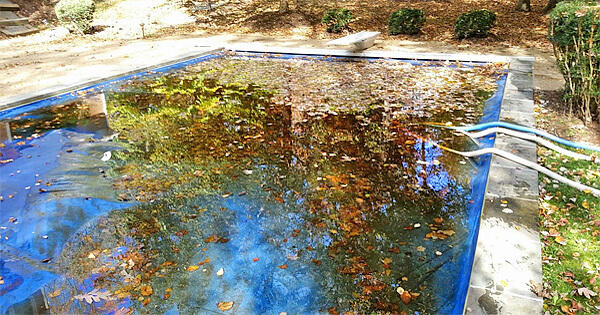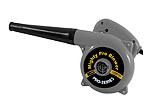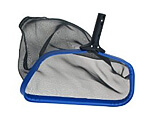FREE Standard Shipping On All Orders $100 or More!*
Removing Leaves from Winter Pool Covers
By mid-November in the US, most of the leaves have fallen as autumn comes to a close. For pools covered for winter, that means thousands of leaves, twigs and other debris that need to be removed, before a hard freeze. It's not nearly as pretty as the picture above.
In-ground pools with safety covers don't have to deal with leaves in most cases - they blow on, they blow off, as the cover is drum-tight and water drains through. Solid covers however, or above ground pool covers, seem to catch every airborne leaf in the neighborhood!
Today we talk about efficient methods of removing leaves from a winter pool cover. Having removed millions of leaves from pool covers during my pool service days, I feel uniquely qualified to teach the subject!
Removing Water from a Winter Cover
Pump-off most of the rain water off first to make removing pool cover leaves easier. Use a submersible pool cover pump to drain the water from the cover first.

Too much water on the cover not only makes it hard to remove leaves from a pool cover, but also puts stress on the cover, which can leak gunk into your pool. When deep water freezes over, sharp edges of the ice sheet can damage your pool cover. For solid covers, you need a good cover pump!
A leaf blower can be used to inflate the pool cover underneath, which moves all of the water toward the cover pump. Stick the blower under the cover, with the water bags or cable still in place. Very useful in springtime, not always necessary for a mid-winter cover cleaning.

A siphon hose can be used with above ground pools or in-ground pools with a sloping hillside near the pool. Fill a vacuum hose or garden hose full of water, weigh down one end onto the cover, cap the other end with your hand and quickly pull the hose to the lowest spot it will reach. Release your hand and gravity will do the rest, removing most of the water. You will still need a cover pump however, when it comes time to remove the cover.
Removing Leaves from a Winter Cover
Using a Leaf Blower

If you keep your pool cover mostly dry, you can simply blow the leaves off with a leaf blower. A large leaf blower can blow leaves all the way to the other side of the pool cover, or off the cover completely. Of course if the leaves are wet, a blower won't work so well.
Using a Pool Brush

As shown below, a pool brush can be used to push the leaves from one side of the pool cover to the other side, where they can be scooped up with a pool leaf rake, or pulled over the edge with a lawn leaf rake. Use only rakes with plastic tines, and pool brushes with nylon bristles, or you may puncture your pool cover.
Using a Pool Leaf Rake

A pool leaf rake is a large skimmer net with a deep bag. Push it slowly across the pool cover to scoop up leaves and debris. Keep a large trash can (or two) on the pool deck to dump the debris, and you can clean a pool cover in no time, even if there is water on the cover.
Using a Pool Leaf Net Cover
Leaf Catchers are sturdy leaf net covers that you lay on top of your regular pool cover, the best leaf removal solution. Once all the leaves have fallen, one person can easily remove every last leaf, in minutes! It's too late to use one now unfortunately, but you can plan for next year!
And there you have it - when it comes to removing leaves from a pool cover, there's a few methods to safely remove leaves and sticks, and even heavy branches, without damaging the pool cover.
Let us know how you remove leaves from your pool cover, leave a reply below for a prompt answer about cleaning pool covers, or any pool maintenance topic!